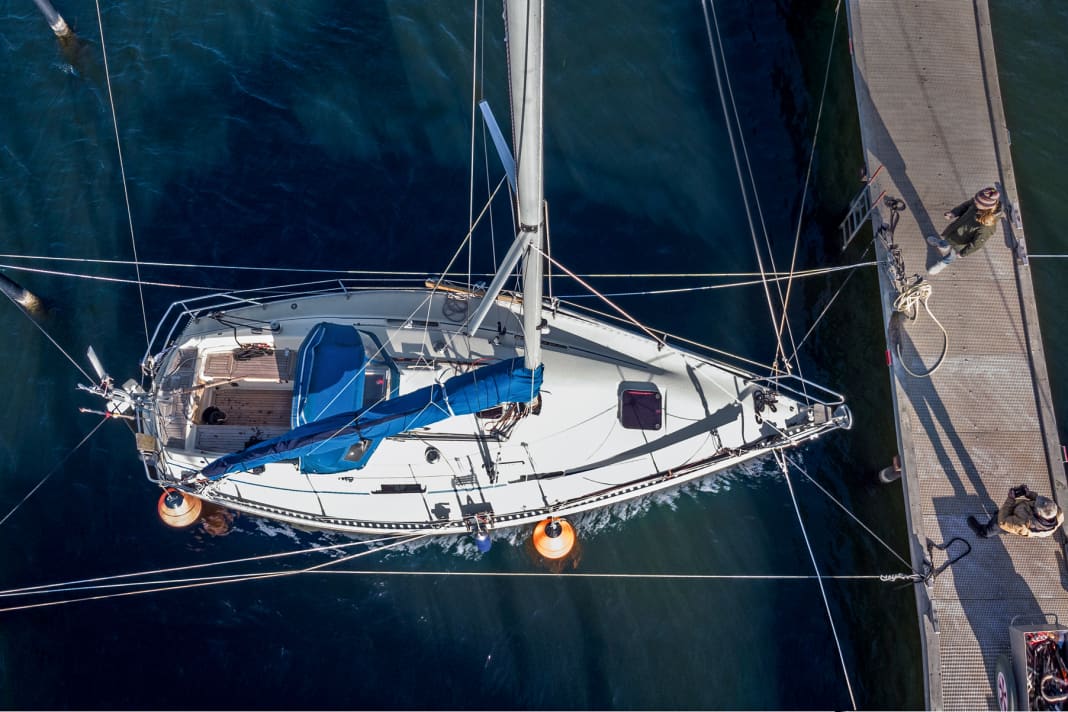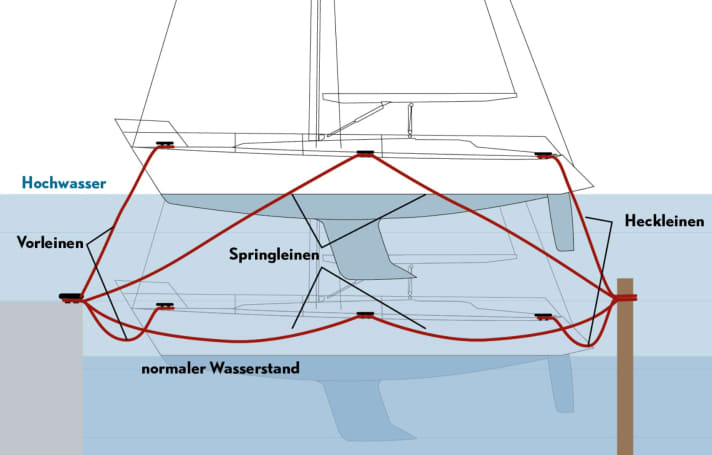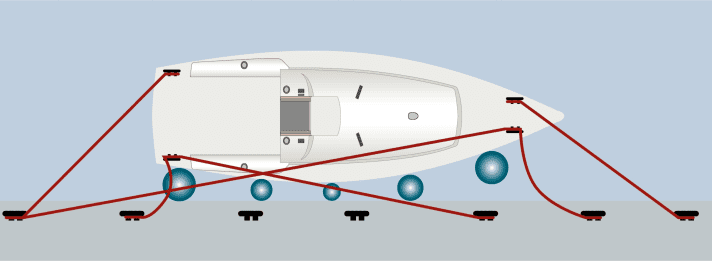





The Baltic Sea storm surge of 2023 left a trail of devastation in several marinas. Given the force of this natural disaster, the question arises as to whether it would have been possible to prevent damage at all. Can anything be done to protect boats when harbour piers are washed over and floating jetties come loose? When mooring lines break and ships drift around freely in gusts of more than 70 knots?
In retrospect, however, it should be noted that several of the damaged yachts could have been saved if they had been properly moored or, even better, moved to a sheltered harbour. While disastrous conditions occurred in Maasholm's municipal harbour, for example, with total losses in the double-digit range, there were more than 50 free berths just half a nautical mile around the corner in the harbour of the Modersitzki shipyard, which is well protected against winds from the east. Almost no damage was reported there. The same applied to harbours on the west and east sides of the Kiel Fjord.
If there is no such option, the only option is to moor the boat in the best possible way. It is important not only to moor the boat before a predicted storm surge. enormous wind pressure. The combination of this with extremely rising water levels in particular poses enormous challenges for owners, because situations like the one in the current case of the Baltic Sea storm surge have not yet been experienced. In the following, we show which basic principles should be observed in the most common mooring situations.
1. in the box at the jetty and dolphins
Normally, most boats are moored here on four lines. The aft mooring lines are placed over two dolphins with spliced or knotted eyes, the two fore lines are placed on cleats on the jetty, and the selected box is longer than the boat.
The mooring lines are not discarded halyards or sheets, but ropes optimised for their purpose. The breaking load and stretch must match the size and weight of the boat. Such lines are stable on the one hand, but elastic enough on the other to protect the boat and the crew's nerves.
Often, the leader lines are set on a slip. This is a disadvantage for various reasons. The mooring lines have less slack, they rub against the cleats on the jetty and take more damage with every movement of the boat. And finally, they cannot be moored from the jetty if the water level changes. In some harbours, mooring on slips is therefore - quite rightly - prohibited by harbour regulations.
Risk of capsizing: what measures need to be taken and when
The better the length of the line, its guide as well as the shock absorber and the stretch are harmonised, the quieter it is for the boat and crew. If there are no shock absorbers to hand, the leader lines can be guided over horizontal fenders with a little improvisation, which can significantly improve comfort on board.
Alternatively, weights on the aft mooring lines can be used to improve the jerk behaviour. Positive side effect: the higher the ship floats, the further the weights slide towards the dolphins and help to keep the lines down.
However, if an extreme weather event such as the recent flood of the century with storms and exceptionally high water levels is imminent, the measures described above will not be sufficient. The rising water level lifted the boats by more than two metres. Sooner or later, the four lines deployed in such a situation come under an ever-increasing pull.
Adjustment: determining the correct length of the mooring lines
This effect is all the more pronounced the shorter the box is, because the steeper the angle of pull of the lines in this case. If the stern lines then lie on the stern posts with only one large eye without further securing, they will jump off at the latest when the water level reaches the height of the dolphin ends. In practice, this will actually happen much earlier due to various other influences, such as the increasing movement of the ship as the swell rises. Apart from the fact that the stern of the ship is now no longer stationary, the next problem is about to arise: The forward mooring lines will gradually pull the boat under water, at least as long as they do not break.
A scenario that can lead to capsizing, as several cases in the last storm surge have shown. If, on the other hand, the mooring lines cannot withstand the strain and break, the ship will drift through the harbour. Usually with similarly devastating consequences.
The way out of this dilemma is to use long boxes and long lines. If possible, the box should be at least three to five metres longer than the boat. The line length can be determined with a simple trick. This involves using a telescopic boat hook and a folding rule on the foredeck. If the water is to rise two metres higher than normal, the boat's cleats will also be higher by this amount than before. If you place the correspondingly cut-to-length boat hook next to the cleat, the point at which it will be approximately at the predicted high tide is located at its upper end. If you now take the lines off the cleats and let them run over the adjusted boat hook, you will find the point that needs to be put back on the cleat so that the line does not come under high tension later.


Set springs: the longer, the better
The same is done at the stern, starting with the stern lines laid crosswise. If possible, their ends behind the cleats are also attached to winches in the vicinity. This way, the boat is still tied to the winches even if the cleats fail. The motto is: redundancy increases safety.
However, as long as the maximum expected water level has not yet been reached, the ship will now drift against the dolphins or jetty, as there is now far too much slack in the lines. Springs are needed to solve this problem. And they need to be as long as possible. To prevent the boat from drifting against the jetty in this situation, lay a long line from a stern dolphin to the centre cleat of the boat, or even better to the bow cleat.
This line is cut to length so that the boat can barely touch the jetty. The same is done in reverse on the other side, so to speak, to prevent the boat from drifting backwards against the dolphins due to the excessively long leader lines. Due to the length of these springs and their considerably shallower angle to the boat, they can cope with large changes in water level.
Since cleats on the boat and on the jetty can come loose, the mooring lines should be distributed to as many points as possible
To keep the bow in the centre of the box, if there are no neighbouring berths in the way, very long fore lines can also be attached, which lead at as obtuse an angle as possible from the foredeck to a cleat further away on the jetty. Here too, the longer they are, the better they can compensate for the coming high water.
This way, the boat is well prepared for high water. If you have enough space, lines, cleats and winches, there is nothing to stop you from doubling up mooring lines or laying additional lines from a centre cleat or from the foot of the mast to the jetty. In this case, a lot helps a lot.
If extreme weather is forecast, it must be assumed that, in addition to your own cleats, attachment points on the jetty may also fail. It is therefore advisable not to rely on just two cleats as usual, but to distribute the load over many points. Perhaps you can lay the lines around the entire jetty or one of its supports, creativity is required here. Finally, especially with such unconventional mooring points, suitable measures must be taken to prevent the lines from snagging.
length runs: For the boat to float, it needs space and long mooring lines
It is equally important to remember that the lines must not come loose even at the highest water level that can be assumed. While this is not a problem with cleats on the jetty, this point of preparation requires a very careful approach with the stern piles. Regardless of whether the dolphins are steel tubes covered with smooth plastic or blunt wooden dolphins, the stern lines must hold on to them. In many cases, the piles are fitted with metal brackets or similar at the upper end. Under normal circumstances, the lines are laid over them so that they do not fall into the water. If extremely high water is imminent, it is advisable to position the stern lines under these brackets.
A loop pulled through itself is often used to attach the aft mooring lines to the pole. This knot holds quite well when under tension, but can loosen and slip when not under load. A stopper knot with two half hitches is better.
You can also weigh down the stern lines. Weights, chains or canisters full to the brim are well suited. As the water level rises, they slide towards the dolphins, losing their function as a shock absorber, but helping to keep the mooring lines on the piles.
2. alongside the jetty or pier
This situation is only advisable in a storm surge with an offshore wind or wind from the front. In principle, the same principles apply as when mooring in the box. Here too, the secret lies in the long lines. The fishermen in the English Channel, who have to come to terms with a tidal range of several metres, can show you how to use them correctly.
The fore spring runs from the front cleat of the boat to a point on land that is as far behind the boat as possible. The aft spring runs in the opposite direction from the aft cleat to a point far in front of the boat.
Additional long lines should be led from the now free cleats on the offshore side of the ship to the front and rear of the jetty.
Distribute as many different lines as possible to as many cleats on the boat and jetty as possible

Here too, it is important to distribute as many different lines as possible to as many cleats on the boat and jetty as possible in order to create redundancies in the event of material failure. The mooring lines are supplemented by two lines that run at right angles from the jetty to the boat and are intended to prevent the boat from moving too far away from the jetty. Their length is again determined using the boat hook method.
The boat should be carefully fendered, especially when moored alongside. If there are fenders of different thicknesses, it is important to distribute them correctly: Thick fenders at the front and rear, their diameter decreases towards the centre of the boat.
To ensure that they are optimally secured, the fenders are attached to the jetty and not to the railing if possible.
3. in the packet
Packet moorings, at least with several sailboats, should be used for upcoming
heavy weather events should be avoided as far as possible. Even if the ships are moored offset, i.e. stern to bow and vice versa, the risk of the rigs getting in each other's way and being damaged in strong winds and waves would be too great.
4. at the floating dock
The seemingly best places at high tide are only safe as long as the jetty in question actually remains in place. During the Baltic Sea storm surge, however, the floating jetties in some places were unable to withstand the forces of nature and broke free or simply swam out of their anchoring. If unusually high water levels are forecast, it is therefore advisable to check whether a floating jetty can withstand them.
Conclusion: Owners can also prepare their ships for a storm surge of the century. In addition to the necessary luck, this can help them to survive unscathed.
5th bonus: the most important rules of thumb in the event of flooding
- Move the ship into a long box
- Bow to the wind
- Extend the fore and aft lines according to the expected water level
- Installing the shock absorber
- Create redundancies for failures: deploy additional lines from several points on board to different points ashore
- All lines as long as possible
- Reduce the area exposed to the wind to a minimum and remove the sprayhood, tarpaulin and sails, for example
- Deploy all fenders
- Cut the shore power cable The author has published a video on the subject of "storm-proof mooring" on his YouTube channel

